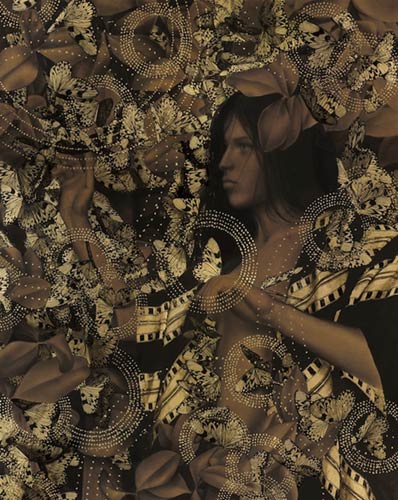Stemming from her interests in Christian iconography, artist Alessandra Peters’ modern visions of female idols comment on the double standards of moral femininity.
For nearly 2,000 years, the Virgin Mary has represented for billions of people especially women – the ideal of virtue, modesty, and motherhood. Indeed, a major part of her divinity stems from her purity, embodied by her miraculous conception. However, while the Virgin provides an exceptional moral and sexual ideal, popular culture often glorifies and encourages the opposite, creating a conflicting message for millions of young, Christian women. Artist Alessandra Peters, who was raised Catholic, took note of this double standard during her formative years in an all-girls high school, which has evolved into a powerful artistic voice. “It was enormously difficult to try and develop a self-identity as a teen because there were so few examples of powerful, sexless femininity,” Peters recounts, “Most young women grow up with the idea that their power is based on whether – and how – they choose to express their sexuality. Everyone is telling you to stay a virgin and everywhere the media is trying to convince you of the power of your sex.”

Alessandra Peters, coffee-stained paper with graphite/carbon pencil, gold leaf and black ink,
(c) Alessandra Peters 2015
“I believe we all need idols,” Peters continued, “and if we don’t have them we eventually create our own.” Creating new, modern idols specifically for women is the core of Peters’s artistic goals. Stripped of her sex appeal, disjointed, powerful, and dark is the stunning “Cleis Rising.” Executed with graphite and ink on stained paper, a half-length female figure stands at center. Her quiet, confident pose and expression are stoic and captivating as she peers outside of the picture. “Her nudity is irrelevant,” writes Peters, “I try to use typical feminine motifs – flowers and butterflies, to give her strength, darkness, and edge.” Adding an extra sensory dimension is the artist’s use of gold leaf, which is beautifully arranged to form a sparkling halo around the subject’s head. What is more, many of the flowers have been embellished with gold leafing as well. The resulting effect on the viewer is entrancing as our eyes vacillate between the three-dimensional and two-dimensional. Although the leafing begs the brain to perceive it as flat, its brilliant illumination leaps from the darkened page while simultaneously disappearing behind the idol and objects surrounding her.

Alessandra Peters, coffee-stained paper with graphite/carbon pencil, gold leaf and black ink,
(c) Alessandra Peters 2015

Alessandra Peters, coffee-stained paper with graphite/carbon pencil, gold leaf and black ink,
(c) Alessandra Peters 2015
Another marvelous example again displays a half-length female figure. Particularly noteworthy from this picture is the liberal use of gold, which composes nearly half of image. In lieu of flowers, the viewer finds a swarm of golden butterflies, their various angles and views activating the artwork with kinetic energy. Adding to the visual texture is an array of dotted, concentric gold circles, which appear to form miniature halos around each butterfly. Were it not for the figure’s outstanding modeling, dark hair and robe, she could be entirely lost in the composition.

Alessandra Peters, coffee-stained paper with graphite/carbon pencil, gold leaf and black ink,
(c) Alessandra Peters 2015
Don’t expect Peters to stop anytime soon. At 26 years-old, Peters has a long career ahead, the prospects of which seem promising. “I have so many ideas, and love pondering that thought,” she writes, “Always improving, always growing, that’s the goal.”
Peters is represented by Arcadia Contemporary in New York and was recently featured in their “Works on Paper” exhibition, which was detailed in an earlier Fine Art Today article here.
To learn more, visit Alessandra Peters.
This article was featured in Fine Art Today, a weekly e-newsletter from Fine Art Connoisseur magazine. To start receiving Fine Art Today for free, click here.







